Content
Smirnov's rhododendron is an evergreen, wide-spreading tree-like shrub. The plant looks great on the site and as part of a free-growing hedge, and as a single shrub, and as a participant in a flower arrangement. Subject to certain conditions, Smirnov's rhododendron grows well in Moscow and the Moscow region.
Description of rhododendron Smirnov
Rhododendron Smirnovii (R. Smirnowii) grows in the lower and middle belt of the mountains of Adjara and in the Artvin district of Turkey. This shrub in nature grows up to 3 m, in cultivation a little more than 1 m. The leaves are large, glossy, oblong, dark green, red-pink bell-shaped flowers are collected in densely flowering compact inflorescences. In the Moscow region, Smirnov's rhododendron begins to bloom in the first half of June. The plant blooms for three months. The fruits set in June, the seeds ripen in late autumn - early November. This shrub is durable; with proper care, it can live for more than 30 years. Frost-resistant, with light shelter it calmly survives winters in central Russia.Smirnov's rhododendron first appeared in the St. Petersburg Botanical Garden in 1886.
Conditions for growing rhododendron Smirnova
Inexperienced gardeners, having seen luxurious photos of Smirnov’s blooming rhododendron and read a brief description of the plant’s characteristics, decide to decorate their plot with it, and then they will be disappointed. A shrub planted incorrectly weakens and dies. This is a shame, because these beautiful ornamental plants can be grown in the Moscow region, Nizhny Novgorod, and Volgograd.
It’s easy to create comfortable conditions for evergreen rhododendrons:
- Rhododendron should be planted in an area protected from wind and sun. It is better to be protected by tall plants, so that a thin, sparse shadow is formed.
- This shrub is moisture-loving, but does not tolerate stagnant water. Therefore, choose a site that does not suffer from melt water and autumn rains.
- Rhododendron prefers acidic, permeable, light soil.
Planting and caring for Smirnov's rhododendron
Planting the evergreen Smirnov rhododendron without taking into account its specific requirements leads to the appearance of weakened, diseased plants on the site, which even subsequent intensive agricultural technology cannot help.
Selection and preparation of a landing site
Rhododendron Smirnova loves acidic, light soils. The planting hole is filled with a mixture of acidic peat, sand and coniferous soil (3:1:2). Coniferous soil (semi-decomposed pine needles) is collected from a pine forest. If the soil is clayey, drainage from sand, stone or broken brick is arranged at the bottom of the pit.
Seedling preparation
Before planting, a rhododendron seedling, together with a lump of earth, is dipped into a solution of sodium humate, a clay mash or water, and wait until the release of bubbles stops. Then the plant is taken out and the roots are straightened, otherwise the seedling will not take root and will die in the winter. Flowers, if any, are removed.
Landing rules
Smirnov rhododendrons are planted in early spring or early autumn. It is better to buy plants with a closed root system, this way the roots and soil fungi are preserved, without which this shrub cannot grow. The depth of the planting hole is 30-40 cm, diameter - 60 cm. Planted flush with the surface of the coma (to the level of the root collar). After planting, the plant is watered abundantly, and the tree trunk circle is mulched with crushed pine bark (needles) or peat.
Watering and fertilizing
To prevent the bushes from suffering from dry air in extreme heat, they are sprayed every evening. The top layer of soil under rhododendron should always be moderately moist; Regular watering (2-3 times a week) and mulching will help here. Nor do they remove their own litter from under the bushes. After watering, the soil is loosened.
Fertilizers:
- Adult plants are fed in the spring with special mineral fertilizers for rhododendrons or Kemira solution (20 g per bucket of water, consumption per 1 sq. m.), compost or rotted mullein are added.
- Young shrubs need liquid complex fertilizers in low concentrations, which are applied in early spring and summer after flowering.
- Twice a year, the soil under rhododendrons is artificially acidified with a dry mixture of 30-40 g of ammonium sulfate, superphosphate and potassium sulfate in a ratio of 2:1:1.5 (during active growth) and a mixture of 60 g of phosphorus and 15 g of potassium (after flowering ).
Trimming
Sanitary pruning of shrubs is done as the buds swell, in order to see which branches or tips of shoots have frozen in winter. Cut out broken, damaged shoots and lightly thin out the bushes. To make the crown dense and compact, formative pruning is carried out in May, but it retards the growth and flowering of the Smirnov rhododendron.
Preparing for winter
The shrub is watered generously before the onset of cold weather (before the first frost), then the trunk circle is mulched and covered. It is better to use black light-proof film to protect the plant from sunburn in early spring and spruce branches to protect it from the cold. It is important to protect the plant for the first 2-3 years of its life. The shelter is removed in early May.
Reproduction
The climatic conditions of Moscow and the Moscow region, according to reviews from professional flower growers, allow you to plant and grow Smirnov’s rhododendron in the garden yourself.
Reproduction methods: seeds, cuttings, grafting on rhododendron ponticus.
Rhododendrons are sown in winter. Coarse river sand is added to the peat humus mixture at a ratio of 3:1. Containers for sowing are chosen to be shallow (5-6 cm) with drainage holes. The soil is moistened, slightly compacted and the seeds are placed on the surface at a distance of 1.5-2 cm from each other. Then the containers are covered with glass and germinated in the light. Crops need daily ventilation and soil moisture. The first shoots appear within a month.
Some nuances:
- pre-sowing seed treatment is not required;
- germination temperature +200WITH;
- seedlings bloom after 6 years.
Semi-lignified stems 50-80 mm long are suitable for propagation by cuttings. The lower leaves are removed, and the cuttings are immersed in solutions that stimulate root growth. After this, they are planted in a soil mixture of sand and acidic peat (1:3) and covered with a glass dome. Rooting takes from 3 to 4.5 months. The cuttings are grown in boxes filled with peat and coniferous soil in a ratio of (2:1). In winter, the boxes are kept in a bright room at a temperature of +120In the spring, the containers are taken outside and buried in the garden plot, where they grow for another 1-2 years. Only after this are the rooted cuttings transplanted to a permanent place.
Diseases and pests
Rhododendrons are delicate plants that are attractive to diseases and pests. To avoid plant death, regular inspection of the bushes and timely treatment are required.
Pests:
- Rhododendron bug. Its presence can be recognized by black-brown dots on the back of the sheet.
- Spider mite - feeds on leaf juices. Infection with it can be easily determined by the appearance of the plants. The underside of the leaves becomes covered with a thin web, and they themselves darken and fall off.
- Sulcata weevil. Adult insects are dangerous to the above-ground parts of the plant, and larvae are dangerous to the root system. Larvae and adults are insensitive to insecticides.
- Narrow-winged miner moth. The damage is caused by caterpillars that feed on leaves. As a result, the leaves become dry, brittle and fall off. They repel the insect by fumigating or spraying the bushes with sulfur.
- Rhododendron fly. You can notice the lesion by light spots on the leaves.This pest is destroyed by spraying with nicotine sulfate.
Diseases:
- Tracheomycosis – damages the vascular system of the bush, leading to rotting of the rhizome. Treatment: spraying with Bordeaux mixture.
- Late blight rot. It affects the stems and root collar of the bush, they become covered with brown or purple spots, then the rhizome rots, then the bush dies.
- Phyllostictosis, pestalocia, septoria spotting of rhododendron. All diseases are characterized by the appearance of spots on the leaves. In the first case, the color of the spots is brown, in the second, dark brown or gray with a dark rim around the edges, in the third, the spots are reddish, gradually turning white in the center. Treatment: spring spraying with Bordeaux mixture, cumulos, fungicide treatment.
- Rust of rhododendrons. The leaves turn red, as if covered with rust spots. Treatment: copper-containing drugs.
- Bacterial canker of rhododendron roots. Gradually darkening round growths appear on the root collar and roots of the shrub, which become hard over time. Plants begin to rot, bloom poorly and die. Treatment: severely affected shrubs are burned along with the roots, weakly affected ones (before the growths harden) are sprayed with Bordeaux mixture.
- Chlorosis of rhododendrons, characterized by the appearance of yellow spots on the leaves. Cause of the disease: increased soil acidity, depleted soil. Treatment: bushes are sprayed with a mixture of magnesium sulfate and iron sulfate (7 g of each substance per 1 liter of water).
Conclusion
Rhododendron Smirnova is a very beautiful evergreen shrub; its high decorative qualities attract the attention of landscape designers and simply flower lovers.At the same time, Smirnov’s rhododendron is winter-hardy, not too demanding and can grow in the central part of Russia.
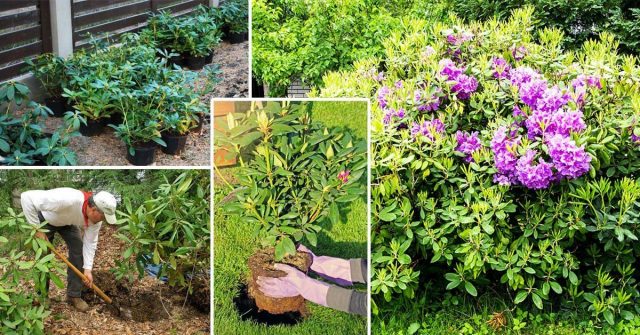
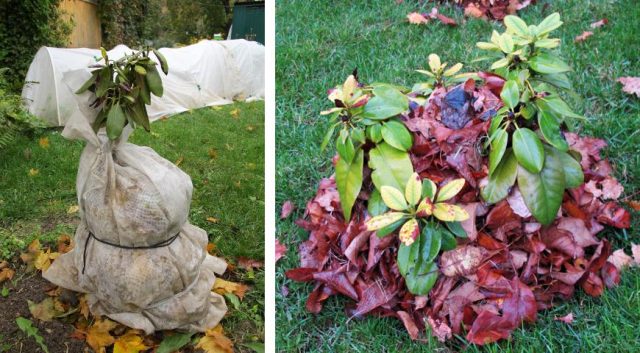
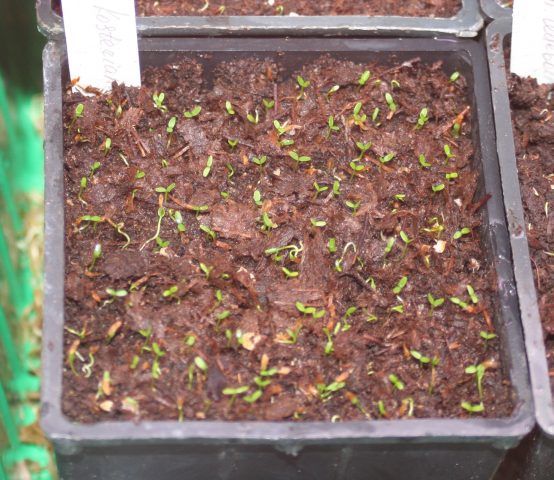

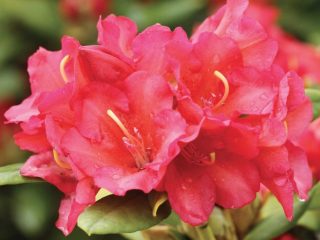

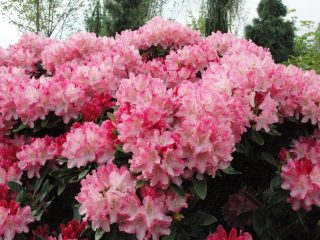
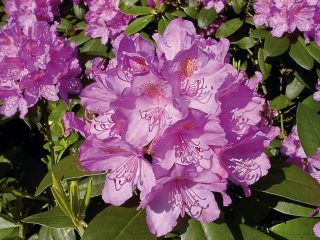
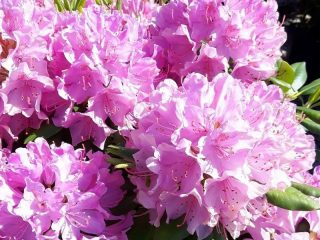
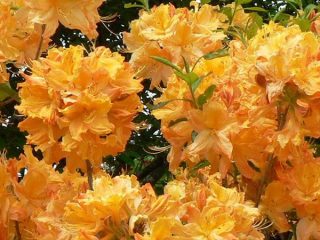

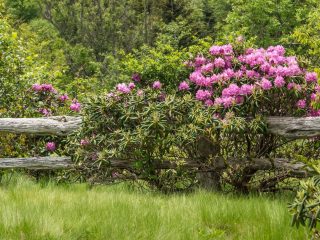
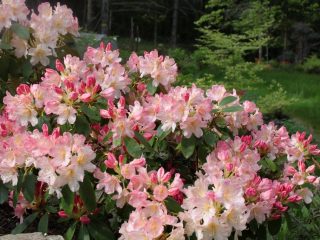
A long time ago at VDNKh, behind the Mechanical Engineering pavilion, there was a plot with Smirnov’s rhododendrons. Their height was more than 1.5 meters, almost 2 m. The plants are powerful. For the winter, the branches were tied together and that was it. But the ground under them was sprinkled with manure. Next to them grew some others of the same size, but their leaves were wider and olive-colored.